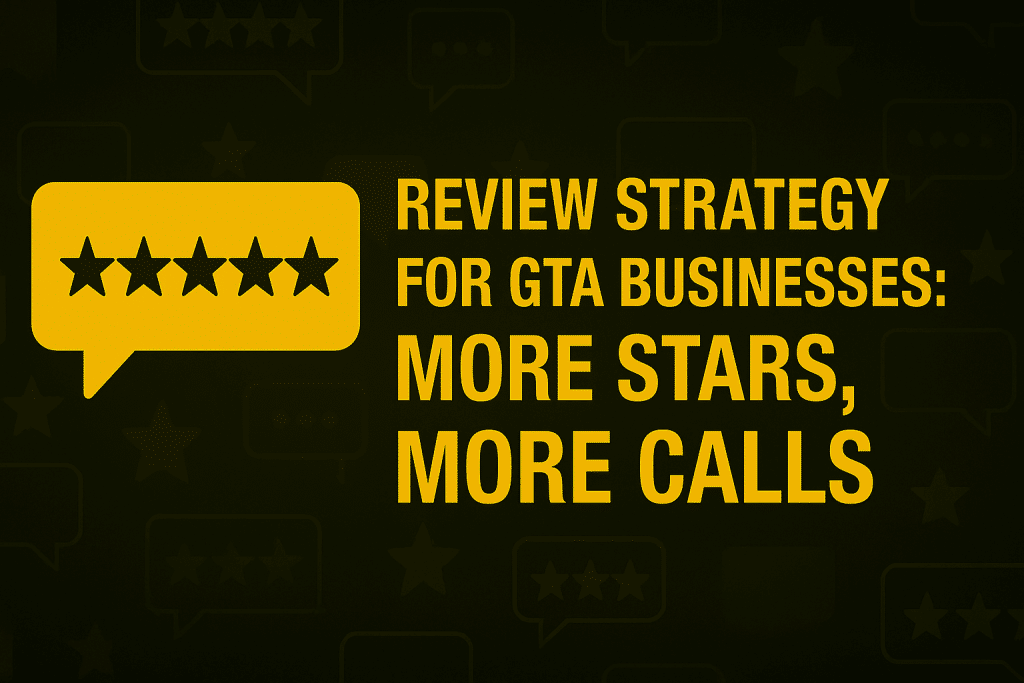Positive online reviews are the modern-day word-of-mouth for Greater Toronto Area (GTA) businesses. Whether you run a local café in Mississauga, a law firm in Downtown Toronto, or a home services company in Scarborough, your Google Business Profile reviews can be the difference between a phone that rings all day and one that stays silent. A smart, structured review strategy boosts both your local SEO rankings and customer trust — ultimately driving more calls, bookings, and revenue.
Understanding the Power of Reviews in Local SEO
Online reviews are more than just vanity metrics. Google considers both review quantity and review quality as key local ranking factors. Businesses with a higher volume of authentic, recent, and positive reviews consistently outperform competitors in the Google 3-Pack, which dominates local search visibility.
A recent Google Business Profile guide highlights how active review management directly impacts rankings and conversions. In the GTA, where competition is fierce across every industry, reviews can make or break local visibility.
Strategic review acquisition should be integrated into broader SEO campaigns. For example, businesses investing in content optimization and technical audits (WordPress Technical SEO Audit Toronto) often pair these efforts with systematic review building to amplify results.
Building a Solid Review Acquisition Framework
1. Identify Priority Platforms
While Google reviews are the most influential, GTA businesses should also consider secondary platforms depending on the niche:
HomeStars and Houzz for contractors and home service providers
Yelp and TripAdvisor for restaurants, tourism, and hospitality
Facebook reviews for local community engagement
Industry-specific directories for professional services (lawyers, accountants, medical clinics)
Linking these profiles strategically across your digital ecosystem — including your website, social media, and listings — ensures maximum visibility.
2. Create a Post-Purchase Review Journey
Top Toronto businesses automate review requests into their sales cycle. Instead of hoping customers leave a review, they make it effortless:
Step 1: Follow-up email or SMS 24–48 hours after service completion
Step 2: Direct link to the Google review form (shortened and trackable)
Step 3: Polite reminder a few days later for those who haven’t responded
Integrating review prompts into email marketing or social media strategies can be highly effective. For example, aligning this approach with choosing the right social media platforms creates a cohesive digital customer journey.
3. Train Your Team to Ask Confidently
In-person requests often outperform digital ones. Whether it’s your receptionist, technician, or sales associate, every team member should know:
When to ask: immediately after a positive customer interaction
How to ask: clearly, politely, and with a simple instruction
What to provide: a direct QR code or link to the review page
This small operational habit can lead to exponential growth in review volume.
Quality vs. Quantity: What Matters More?
Quantity Drives Visibility
A consistent stream of new reviews signals to Google that your business is active and trusted. In competitive Toronto sectors like real estate and home renovation, having 50+ recent reviews often correlates with appearing in top local results.
Quality Drives Conversion
However, 5-star ratings alone aren’t enough. Detailed, keyword-rich reviews provide additional SEO signals. For example, a review mentioning “fast roofing service in Etobicoke” can help your business rank for long-tail search terms.

Diversity Adds Credibility
A mix of review lengths, star ratings (mostly positive), and platforms builds authenticity. Businesses with only perfect 5-star ratings often raise suspicion among savvy GTA consumers.
Handling Negative Reviews Professionally
Even the best businesses receive occasional negative feedback. What sets leaders apart is how they respond:
Respond Promptly – Within 24–48 hours shows attentiveness.
Acknowledge the Issue – Without defensiveness.
Offer Resolution – Take the conversation offline to resolve.
Follow Up – Sometimes, customers update their reviews after resolution.
According to Statistics Canada reports on consumer behavior, businesses that respond to negative reviews see higher retention rates than those that ignore them.
Public responses also demonstrate professionalism to potential clients, building trust even in the face of criticism.
Leveraging Reviews for SEO and Conversions
Embedding Reviews on Your Website
Featuring Google or third-party reviews on high-conversion pages (such as service or contact pages) increases time-on-page, trust signals, and engagement. Coupled with content silos and internal linking structures (Content Silos Toronto), this strengthens on-page relevance.
Using Reviews in Local Landing Pages
Creating location-optimized pages for different GTA neighborhoods (e.g., Brampton, North York, Etobicoke) with embedded, relevant reviews boosts keyword targeting and geo-relevance. Pair this with strategies like ranking location pages in Toronto and GTA for maximum visibility.
Incorporating Reviews in Paid and Organic Campaigns
Top agencies are combining Google Ads and SEO for visibility (Why Toronto Brands Are Combining Google Ads and SEO). Adding review snippets to Google Ads and organic meta descriptions significantly boosts click-through rates.
Automating Review Management with AI Tools
With the rise of AI SEO services in Toronto, smart businesses are using automation to streamline review collection and analysis. AI tools can:
Automatically send personalized follow-ups
Categorize reviews by sentiment and topic
Generate response templates to speed up engagement
Identify trends for service improvements
Adopting such tools aligns with AI-powered SEO trends shaping Toronto’s marketing landscape, as detailed in The Future of Local SEO: How AI Helps Toronto Companies Rank in Google Maps.
Common Mistakes GTA Businesses Make in Review Strategy
Asking Only Once – One reminder isn’t enough; follow-ups are essential.
Incentivizing Reviews Improperly – Offering discounts for positive reviews violates Google’s policies.
Ignoring Industry Platforms – Relying solely on Google can limit reach.
Not Monitoring Competitors – Competitor analysis reveals opportunities to outpace them in volume and sentiment.
Failing to Integrate SEO – Reviews should reinforce broader SEO strategies, not operate in isolation.
Advanced Tactics to Outrank Competitors
Segment Review Requests by Service Type
Create targeted review links for specific services (e.g., “Toronto Window Cleaning” vs. “Commercial Carpet Cleaning”) to build keyword-rich content around each offering.
Time Review Requests Strategically
Ask during peak satisfaction moments — right after problem resolution, quick delivery, or an exceptional service experience — for more detailed, positive reviews.
Use Schema Markup
Adding Review schema to your website allows Google to display star ratings in search results, increasing CTR significantly.
Monitor Competitors’ Review Velocity
Using local SEO tools, analyze how fast competitors are gaining reviews and match or exceed that rate to stay ahead in local rankings.
Turning Reviews into Leads: The Final Step
A great review strategy doesn’t stop at collection. It turns reviews into tangible business growth:
Showcase top reviews in retargeting ads to reinforce trust.
Highlight testimonials in sales presentations for B2B services.
Feature real customer stories on landing pages to build emotional connections.
GTA businesses that treat reviews as a growth engine — not just a marketing checkbox — consistently dominate their verticals.
Conclusion: Build Trust, Rank Higher, Get More Calls
In the GTA’s competitive business ecosystem, reviews are a direct ranking and revenue lever. By combining structured acquisition, professional response management, and SEO integration, businesses can dramatically improve their online reputation, attract more local traffic, and convert those searches into calls.
For a personalized strategy tailored to your business, contact Toronto SEO and start building a review system that delivers measurable ROI.


